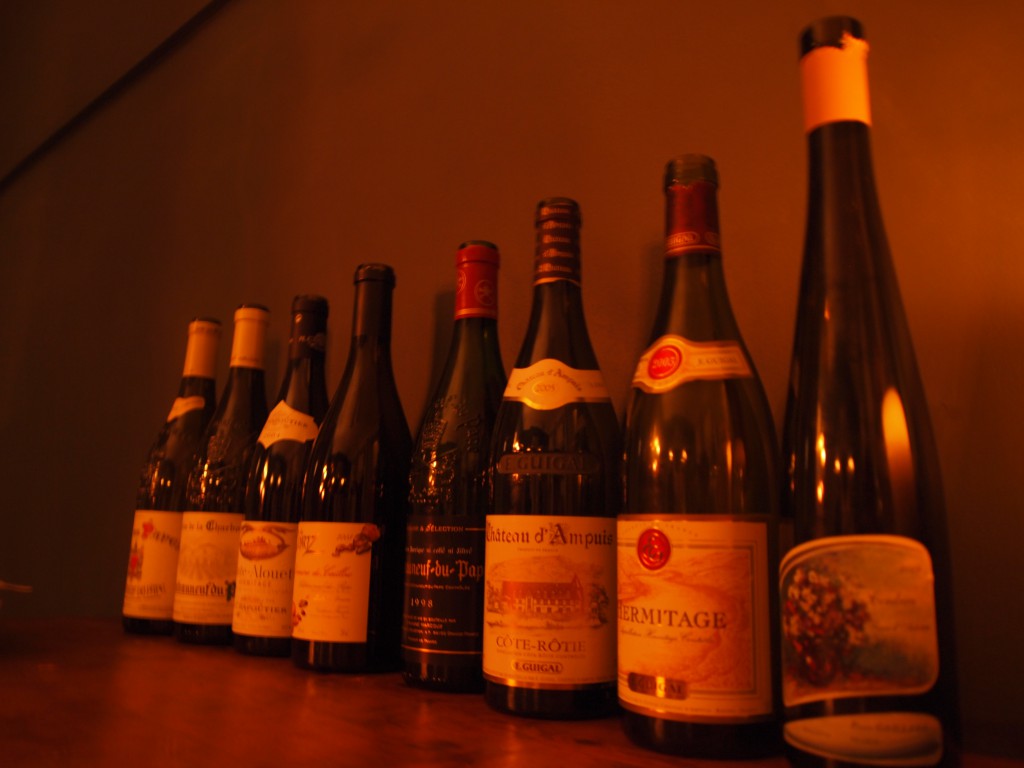by Wine Owners
Posted on 2020-06-04
Chevalier is out this morning at £247 per 6, a perennial favourite and on the back of a seemingly great success in 2018. Hopefully in 2019 they’ll have tamed the merlot alcohols which hit 15 degrees in 2018. Bordeaux being blends saved the day and early pickings of Cabernet brought the assemblage down to under 14 degrees. Still, that kind of inherent excessiveness does make you wonder. Chevalier does age with unusually consistent grace no matter the kind of vintage.
Relative value analysis points to 2014 as being a rather decent pick of an excellent run of recent vintages. 2019 is fairly priced for collectors of this lovely estate but not to attract the short term profiteers.
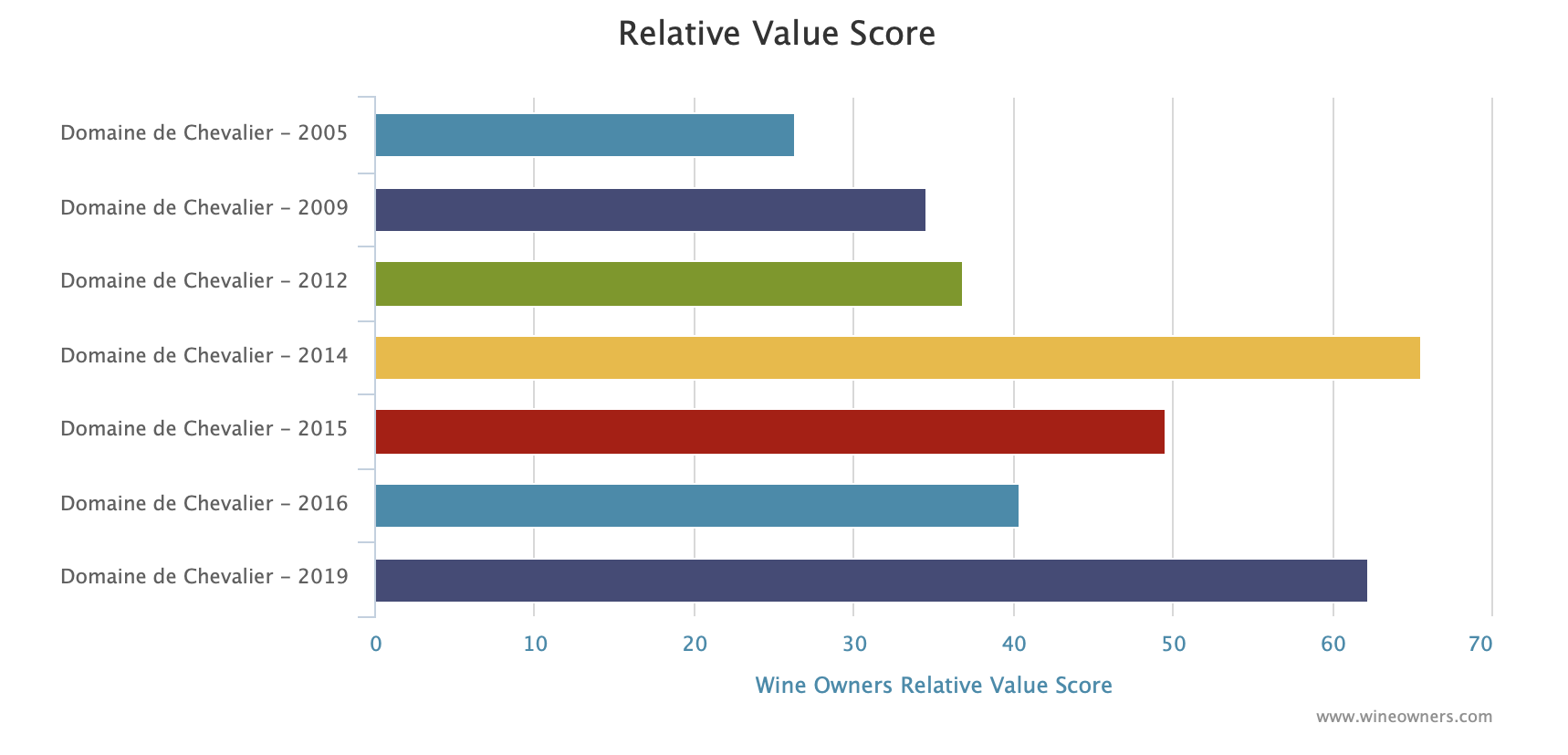
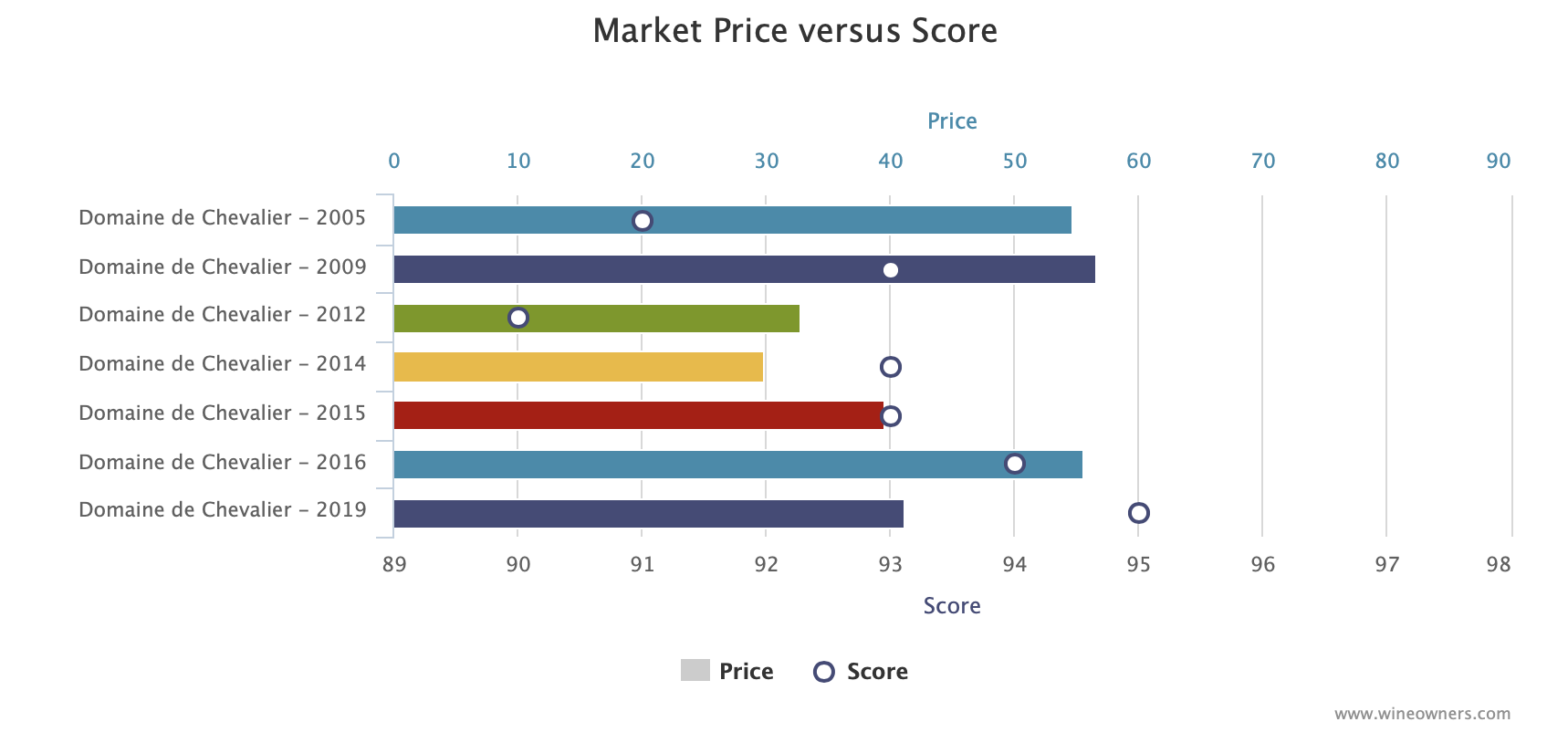
Banner Image: http://www.domainedechevalier.com
by Wine Owners
Posted on 2018-12-17
Ahead of the new 2017 releases in early 2019 it's time to report on Burgundy and its news.
2017
Another warm summer produced accessible, fruity wines.
Left to do their thing, the vines were wont to produce very high yields especially in areas hit by frost damage in 2016 as the plants strove to compensate. Yields in Chardonnay were as high as 80 hl/ha. Now that’s a lot.
With a long run of short harvests stretching back to 2009 for several communes, the temptation was to let nature’s abundance run unabated. The trouble is, pinot noir is particularly susceptible to a large crop, so the trick in 2017 was to work to constrain yields.
Just as many over-cropped 1999s are now showing flat, far from being the great wines they might (and should) have been, we shall see which producers in 2017 haven't applied the brakes hard enough in due course.
For those who produced normal yields, 2017 is a delightfully juicy, fruit-forward year. Yet the best wines have more than just fruit: there is a fine mineral structure, a chalkiness and salinity that complements the raspberry coulis, kirsch, griotte, plum and fruit pastille characteristics.
The best pinots show appealing sucrosité with plenty of supporting freshness, which contributes to a sappy, mouth-watering persistence.
Above all I loved the harmony, balance, progression and energy of the best reds. I wouldn’t be surprised if they never shut down, and stay delicious from early on in their development throughout a moderately long drinking window: after all the 1997s are just about still hanging in there these days, and the 2017s have the potential to be rather better.
The perfect 2017 pinot has flowing raspberry fruit, a vinous, kirsch-like refinement, an infusion of Seville oranges and hints at a darker side with liquorice and spice.
The question mark over 2017 is whether a proper degree of intensity has been achieved. The vintage doesn’t seem to reach the same level in general as 2016, and yet the greatest 2017s do rival (and in a few cases surpass) their 1 year old siblings.
2017 is also very much a vintage where the appellations are reflective of their classification. Stepping up through a range from Bourgogne, through village wine and premier cru up to grand cru feels like an exercise in stepping up through the gears, with more oomph and interest at each change.
Whites are generally delicious as long as yields were tightly managed, and though the acidity levels were apparently a little less than in 2016, the very best still show a notable pithiness, a chalkiness and a bright intense citrus core that successfully counterbalances a tropical fruit character of pineapple and guava.
2018
Looking ahead to 2018, this is going to be a very tricky vintage. It was really hot, and the choice of picking date will have been critical.
Many producers were searching for perfect phenolic ripeness, waiting until the pips indicated an expected level of maturity. Some producers believed that perfect phenolic ripeness was not the only deciding factor for picking a harvest date in 2018. Those that were concerned about alcohol levels went early. They got their grapes in as early as the start of the last week of August finishing during the first week of September.
Producers needed to avoid too much extraction in 2018 for fear of introducing bitter flavours, especially those who had gone early. The gentlest of infusions seem at this very early stage to be the making of the best wines. Even so you won’t see many wines straight out of barrel with that trademark shining ruby robe of classic burgundy in 2018.
The most exciting wines tasted from barrel were made from grapes carried in at around 13.5 degrees but there are tales of 15 or (even!) 16 degree behemoths, whilst 14.2-14.5 degrees feels like a norm in the vintage.
The early pickers were fearful of what might happen if they let the alcohol levels rise too far, and they were evidently right. There were very real risks of partially completed fermentations and consequent high residual sugars in the juice. Several producers we spoke to had a battle to restart stalled fermentations, typically by tipping in the lees of another wine that had completed its fermentation more successfully.
The wines are largely dark purple or purple-black, opaque in appearance, and unsurprisingly show exuberant New World fruit and tend to have a mouth-coating texture due to the higher alcohols. There are some who argue that this is a very great vintage in the making; that vintages like 1947 were very hot indeed and yet they have transformed into great old bones. Taking a necessarily broad view at this early stage I would suggest that there are likely to be a rather small number of potentially very great wines.
Amphorae
Fourrier continued experimenting with Amphorae in the 2017 vintage with La Combe aux Moines, but they are sure to come into their own for 2018. The terracotta enables the wine to breathe whilst acting as a totally neutral vessel. This accentuates minerality and produces a wine – if unblended with wine aged in wood – that would be too strict. Certain of his wines including Clos St Jacques and La Combe aux Moines have a proportion of the production being aged within these fabulous looking clay containers for the 2018 vintage. The finished wine will be blended with the other part of First floor in barrels. It will be fascinating to see the results – could these turn out to be some of the greatest wines ever made at this wonderful domaine?
2017 – The year that distribution changed
Producers are not blind to the fact that certain merchants have been selling their UK en primeur allocations to Asia, notably Hong Kong. They are not happy to discover that importers cross geographical boundaries, even if the wines sold may be subsequently stored for a period of time in the UK.
Nor are their agents impressed, who have the clout to recommend their producers shift allocation to where demand is currently being met indirectly.
As a result certain top producers have withdrawn a significant part of their allocation to the UK in favour of Asia, even though there is much more wine this year to go round - in some cases up to 3 times the quantity of 2016.
2017 pricing
With Brexit uncertainty depressing the Pound, more wine not necessarily translating into larger allocations for the UK, and the secondary Burgundy market having risen substantially during the course of 2018, there are few reasons to imagine that prices will fall. Which makes it a tricky call for consumers who don't want to lose their allocations and yet this is one of the most uncertain of times. High release prices for great vintages such as 2015 and 2016 were swallowed. We will have to see how digeste 2017 proves to be.
by Wine Owners
Posted on 2018-10-17
When tasted from barrel in the spring of 2017, it was very evident that this was a vintage with loads of extract, with one of the highest ever IPT levels ever recorded in Bordeaux. IPT is a measure of the combined phenolic compounds in the juice - principally tannins and colorants responsible for the red, purple and blue hues in grapes. Large bunches of rather small berries meant high skin to juice ratios.
We suspected that the finest wines were those who extractions were gentle - neatly summarised by Frédéric Faye at Chateau Figeac who described their fermentation process as an ‘infusion’ with the gentlest of extractions achieved from the submerged cap.
With the proviso that the 2016s have been in bottle for as little as 3 months, this was an opportunity to re-taste a selection and test our original impressions from 18 months ago.
The more extracted wines with highest IPT levels were evident, and at this stage it has to be said that they were the least harmonious. Where there was a desire to make full use of, or to accentuate, all the elements proffered by nature, the palate tended to be dominated by raw power, the scale undeniable but at the expense of charm for now.
The structure of 2016, hidden under a cloak of velvety fruit and sweet tannins when barrel samples, was much more evident now the wines are in bottle, and this structure allied to tremendously aromatic fruit in the best examples, affirms 2016 as a vintage with some truly great wines in the making.
It’s not just a great cabernet sauvignon vintage either, with some of the right bank merlots absolutely stunning. La Conseillante that had seemed a little sweet and svelte at the property in April 2017 is now brilliantly pitched, with extremely expressive and aromatic fruit held in check by an impressive frame of tannins.
What was slightly surprising however, was the wide variation. Those who are tempted to categorise 2016 as a uniformly great vintage will be disappointed; there is plenty of dull wine. The difference between the vintage's heights and the good average is a chasm.
The Northern Medoc had an especially successful vintage, with Cantermerle showing excellent concentration and focus, and my pick of the appellation at en primeur, Citran, showing all of its former promise and more. Could this be the bargain of the vintage?
Domaine de Chevalier has made an epic red, with great substance and lovely resonance, and on this showing had the better of the high-in-cabernet-franc Carmes Haut-Brion. Though evidently fine fruited, Haut Bailly’s firm tannins are a bit overwhelming for now. Both Pape Clement and Smith Haut Lafitte major on great substance and scale, but show a raw or unknit character at this early stage.
Canon was showing very defined fruit with loads of grip but for now felt very slightly loose on the finish. Figeac has managed to combine stunning definition, texture, harmony and length and on this showing must be a 100 point wine in the making.
Gazin was absolutely charming with an impressively solid core. La Conseillante as already mentioned was a hit.
St Estephe and Pauillac were as good as expected given how fine the Cabernet was from this upper part of the Medoc peninsular, and wines from Cos Labory and Phelan Segur were notably excellent at their price levels.
Clerc Milon had stood out as exceptional in April 2017, and now in bottle shows impressive density, a huge finish and attractive gaminess. D’Armailhac was extremely exciting, packed with red fruit and finely beaded acidity and plenty of accompanying structure. Pichon Longueville Comtesse was one of the stars of the en primeur tasting and once again stood out for its super-refinement: unquestionably a top wine of the vintage.
In St Julien the Bartons stood out. Langoa was svelte, intense, showed gorgeous scale and definition at a very attractive price point. Leoville Barton was another league and heads above the other St Juliens. Huge, but super fresh, light-footed, with a mouthwatering blood orange infused core and a very direct, linear finish. One of the greatest wines of the vintage.
Lagrange was fine, the tannins so ripe and silky that their velvety texture cloak its underlying structure, just as it did when tasted in London a year ago. Talbot was back to it’s very best, likely up there with its beautifully balanced 1982.
The Margaux appellation in the main was not quite as exciting as the magnificent 2015s, a vintage in which the commune excelled. However one stood out for it’s stunning definition and extraordinary elegance. A fitting wine to finish this round-up of 2016s in bottle. Beautifully textured. A wine that simply flows across the palate with effortless grace. It helps that it’s also one of the most under-rated wines in the whole of Bordeaux, sitting as it does on great terroir. The wine in question is Chateau Dufort-Vivens, Second Growth Margaux, fully biodynamic, and an outstanding success in 2016.
by Wine Owners
Posted on 2018-06-06
Hosted by Flint, tutored by Alec Seysses, this was an unforgettable dinner. The wines are hedonistic, show great intensity of flavour and grand dimension. But they are not heavy or dense. They are wines of intensity and breadth rather than weight.
2011 Bonnes Mares
Alec said that they extracted a little more than they might normally have done. The colour is a darker shade of purple, whilst at first the nose is dense and rather closed. There is a boatload of liquorice evident at entry and on the mid palate, with iodine, orange and thyme.
With air the nose opens up to reveal lavender and plum skins, a sweetly perfumed mid palate and a velvety texture. Great length. Complete.
93
1998 Clos de la Roche
At first a tight nose, with a sweet undercurrent. With time in the glass, classic tertiary pinot aromas mingle with lemon verbena. A fresh attack is followed by citrus fruit, and a sappy, mouth-watering mid palate. There’s great persistence to the finish with a classic pinot character. Showing plenty of life and suggesting a great mid term future over the next 5 years.
93+
1997 Echezeaux
Expansive nose of angelica, sandalwood and iodine. Quite broad, very tertiary, leafy and resolved with a medium-long finish.
92
2007 Clos St. Denis
Sherbetty nose, broad pinot nose, herbal and saline. Delightful fruity mid palate, redcurrent and cream, a touch of liquorice, sweet fruit but lifted by a gently freshness. Hedonistic.
94
2002 Clos St. Denis
Perfumed, deep nose, a hint of game with a consommé-like infusion, saline. That gamey complexity shows up again on the front palate before broad orange-infused flavours channel the wine into the mid palate. Terrific focus. Moderate weight but great intensity, very complex with an unami and saline character building out into the long finish. Very 2002 in its precision and energy.
98
1999 Clos St. Denis
Oranges and other citrus fruit on the nose, with lemon verbena adding a herbal character. Gorgeous velvety texture, a really visceral wine. Liquorice, orange pith, great intensity and a really solid core. Compact and immensely deep. Orange rind on the finish. Very young and tight as yet.
96
1999 Echezeaux
A pinot ‘qui pinotte’ – that classic nose exhibiting tertiary pinot character of strawberries ‘on the turn’ mixed with damp undergrowth. Just classic. Gentle resolved wine. Some resonance on the finish. Deceptively mid-weight with alluring intensity.
92
1999 Clos de la Roche
Great complexity and depth. Orange infused nose, saline with perfume of wild broom. Cloved, liquorice attack, and a hedonistic and visceral mid palate. Great resonance. Orange peel, sherbettty sweet fruit. Amazing freshness and length. Goes on and on. A legend.
97+
1999 Bonnes Mares
Expressive aromatic nose, really quite open and sweet. Ready to go, right in the middle of the red to black fruit spectrum. Fruity jujubes and as you might expect a sweet mid palate. Calmed down with 30 minutes of aeration in the glass to reveal a fresh finish that lengthens correspondingly.
93
Caroline Brangé ©Nick Martin
by Wine Owners
Posted on 2017-02-06
Let me first put my hand up and say I’m a fan of 2014 as a Burgundy vintage. It seems to me to be a year of rather lovely balance across the board. No doubt with exceptions, it’s a vintage to buy as high up the qualitative tree as you can afford, quite unlike 2015 where the hot summer provided a metaphorical leg up to wines on cooler, less exposed sites and colder soils.
Adam Brett-Smith, Managing Director of Corney & Barrow the UK exclusive agent for DRC, describes 2014 as the ‘happy vintage’ but warns that it’s easily underestimated. I do agree. The wines may be ‘on the fruit’ and correspondingly expressive, but there’s sufficient fine-grained structure, dry extract and acidity to see the wines develop over the medium to longer term.
The ability of Burgundies to age from classic or un-showy vintages seems consistently under-called by wine critics, especially where there’s a degree of natural concentration through moderate or normal yields, which seems to make a big difference to the finickety nature of Pinot Noir. 2014 should age effortlessly for 15-20 years.
TASTING NOTES
Corton
Warm, red fruited nose. An expressive, spiced attack with nice energy and a twist of licorice. A degree of firmness merely hints at the character of the archetypal Corton appellation (although there is huge variation between the various Corton soils) and leads into a giving, fruity finish.
Échézeaux
An inviting yeasty nose, in turn earthy and creamy. Once again, a degree of firmness that’s overridden by open, expressive, croquant fruit. It’s a wine that pinotents – delivering the essence of Pinot Noir, into a finish that’s framed with an orange citrus cut.
Grands Échézeaux
A fresher nose, vinous and earthy. There’s greater complexity, finely balanced with a bit more structure, more defined and an elemental, vinous character. On its reserve for now, with a freshness and depth that tempts a prediction of a great GE.
Romanée-St-Vivant
Sweet pastille fruit on entry, less evident grip, more expressive with greater mid palate volume. Super upfront fruit with a fine grained back palate. Freshness kicks in on the finish with good persistence.
Richebourg
Liquory aromas rise from the glass. Power comes through on the nose but paradoxically there’s a balancing restraint to it. Greater intensity than preceding wines, much less up-front fruit but with a bit more torque - progressive, earthy and very complex. Flashes of fruit push through, towards a grainy back palate with building intensity. Real grip and substance with old vine character.
La Tâche
Another step up, right now it presents as a more chiselled form of the Richebourg, a rather elegant and cushioned expression of La Tâche at this early stage. There’s lots of latent power and a sense of reserve on the back palate with a long and persistent finale.
Romanée-Conti
Expressive nose of fruit, earth, and a greater sense of minerality. Powerful yet very refined. Darker character, with a brightly illuminated outline to the dark fruit. A controlled finish with fine-grained grip and a sense of penetrating depth.
by Wine Owners
Posted on 2016-03-16
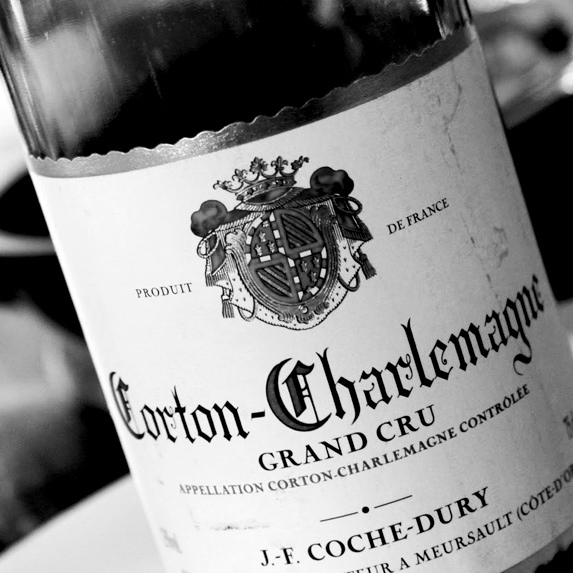 OWNER
OWNER
Domaine Jean-Francois Coche-Dury
APPELLATION
Corton-Charlemagne
BLEND
Chardonnay
AVERAGE SCORE
95/100

REVIEW
Black tea, pugent herbs, iris, narcissus, and an alkaline, saline note suggestive of ocean breezes greet the nose. On the palate, this grips with penetrating pungency and tactile stoniness, leaving behind a memorable concentrate of chalk, salts, faintly bitter herbal essences, along with marrow and animal bone reduction. Surely it will go on to further glory in the bottle and should reward 15 or more years' cellaring. (Robert Parker, 2008)
SEE FULL PROFILE
by Wine Owners
Posted on 2016-03-03
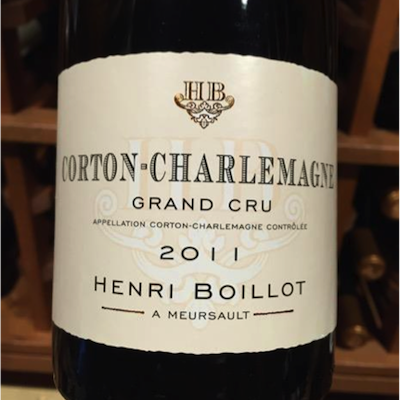
OWNER
Domaine Henri Boillot
APPELLATION
Corton-Charlemagne
BLEND
Chardonnay
AVERAGE SCORE
94/100
From the 5th of July, 2014 the value of the wine has steadily appreciated from £808, peaking at £1048 as of 3 March, 2016. (Overall: steady growth)
Yellow: 2008 Green: 2009 Purple: 2010 Blue: 2011
REVIEW
This flight of 2011s comes to a close with the 2011 Corton-Charlemagne, a cool, introspective and powerful wine. Layers of bright citrus, mint and crushed rocks fill out the wine's big, broad-shouldered frame nicely. The intense, tight finish suggests the Corton-Charlemagne is going to require a measure of patience. Based on what I tasted, it's hard to argue that point. Boillot seems to be one case where the 2011s have the potential to be better across the board than the 2010s. (Robert Parker, Aug 2012).
by Wine Owners
Posted on 2015-12-09
Robert Parker has consistently highlighted low yields over the years as a key indicator of quality. It’s a belief over which he’s been challenged by producers and experts alike.
But is he wrong? Are low yields a prerequisite for wines of character and nuance that we so crave, or is this just a red herring seized upon by eager wine writers whose understanding of winemaking techniques are inadequate?
Jordon Ross of Oenology International points to a run of vintages where the worst wines from the key regions of Bordeaux, Burgundy and California were made from lowest production vintages, whereas the best wines came from those where production was highest.
His misgivings, and those of producers he interviews such as Dominique Lafon, are down to the belief that low yields sell wine and that old vines do not necessarily produce better wines than young vines.
M. Lafon highlights an extreme case to argue that view “Some producers here are talking low yields but with so many dead vines in their vineyards that it’s nonsense, it means nothing.”
That’s as maybe, but let’s not allow rotten vineyard husbandry to define the argument and allow the rejection of the notion that low yields might nonetheless be an important factor behind quality.
I for one am more than happy to accept that a little knowledge is a dangerous thing, that my own technical base - like the know-how of most collectors - is relatively scant, and that it’s easy to grossly oversimplify.
However, I do possess one means of very subjectively putting the question to the test, and that’s my palate. When all is said and done, surely that’s what matters most?
Burgundy seems to be a particularly good and topical reference point when discussing yields given the run of low yield vintages the region endured 2010-2014.
The true colours of a fine wine show with age, long after they've been evaluated by tasters in their first blush of youth (or in the case of Burgundy as échantillons untimely plucked from the comfort of their oak casks).
Vintages blessed with good production volumes and generally fine weather - 1990 and 1999 being prime examples that were lauded upon release - whilst studded with beautiful wines, contain as many examples that are bland and fruity, but fall short of complex or exciting.
On the other hand, there are many wines from low-yielding vintages characterised as difficult or gawky upon release, which 15-20+ years on show a level of intensity and aromatic complexity that are more than a match for the bigger, ‘better’ vintages. For example, there are truly wonderful wines from 1998 (Gouges, Barthod, Bachelet, Mortet) that at release were described (correctly in my view) by Jancis Robinson as ‘tough and stolid’. 18 years on, and they have matured into exceptionally complex, deeply toned wines.
Seeking out the best producers is a must of course, since there are great, good, average and awful ones irrespective of anything else.
Talking of great, no one does it better in Barolo than Roberto Giacomo. His transparent Monfortino 2002, with its tiny yields from a dismal vintage, is a very special wine of weightless proportions. It will never be mistaken for a hot year like 1997 or 2004, but so what? The wine has a rare aromatic subtlety and sweetness that makes it a rarity.
So what of more recent vintages? Bill Nanson talks about 2012 red Burgundy as a vintage visited by ‘the four horsemen of the apocalypse’! It wasn’t easy and yields were considerably reduced. Will it prove to be a great vintage? I believe so, with the best wines surely destined to be as good as 2010 or 2005. There is a fabulous vitality to the vintage that ought to see the best examples blossom into wines of great character.
As if that wasn’t bad enough from a vigneron perspective, 2013 was worse: an exceptionally low yielding year, blighted by a summer that only dared speak its name in July. Although the wines can seem lean and dry at times (evident in January 2015’s échantillons in London), on another day from barrel in situ they show fine, sappy, delineated fruit.
Even though 2013s have higher acidity levels and bright flavours, my guess is that the miserly yields and consequent concentration of juice will compensate over time and make some fine older bones, unlike the much higher-yielding 1996 vintage which remains angular and more often than not lacking.
So far we’ve discussed low yields resulting from nature’s hand.
When it comes to the age of vines and yields per vine, it seems to me the argument is rather more clear-cut. Assuming the producer puts the necessary time and effort into vineyard husbandry, older vines and the naturally occurring lower yields seem to very obviously impart intensity and complexity to the end result. When Clive Coates talks about ‘creamy old vine flavour’ I get what he’s describing.
So, whilst accepting that low yields per se do not necessarily mean good wine, to deny its very significant contribution to creating truly great wines and their appreciation seems unnecessary.

by Wine Owners
Posted on 2015-02-09
The morning after the night before, following a DRC dinner led by Aubert de Villaine in the wonderful setting of the Cutty Sark in Greenwich. The two stars of the evening had been a mind-blowing Batard-Montrachet 2000 that kept expanding with time in the glass, and La Tache 1991.
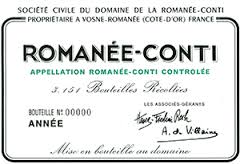
The 2012s presented a contrast to the more delicate, ethereal 2011s. These were firmer wines with iron-infused finishes. Darker-veined, rooted in a firm mineral character in contrast to 2011's brighter, airienne nature.
The Echezeaux was a great deal more open than the Grands Echezeaux, with less grip but enticing acidity. A dark streak of fruit, developing freshness and lift, carried forward. Lovely progression and really salivant.
Grands Echezeaux showed a darker character and a creamy trim. Firm and savoury, a licorice mid-palate, grainy and grippy with a similarly firm, iron finish.
Whereas RSV 2011 seemed more complex and coiled than Richebourg of the same vintage, in 2012 the reverse seemed true:
Richebourg exhibited a heady nose, deep and figgy, with great intensity on the palate. A big core of fruit and a firm, closed, iron finish.
RSV's nose was rather far less visceral, but sweet as fruit-gums, direct and joyful. On the palate the wine was more elemental with a sense of breadth, and a tongue-numbing licorice intensity ahead of a firm finish.
La Tache was a corresponding step up from the Richebourg. A perfumed nose set it apart from the preceding wines, at once ethereal and creamy. Very powerful entry, great intensity, a touch of iodine and iron framing a firm finish.
Romanée-Conti was equally perfumed but more focused. A palate of enormous, uncontainable volume. Such depth, whilst citrus notes and a lifted finish provided the perfect counterweight to a profound wine.
by Wine Owners
Posted on 2014-07-01
Wine Owners celebrated the start of the summer with a Rhone dinner for collectors and enthusiasts at our favourite Farringdon local the Quality Chop House. With everyone bringing an interesting bottle along, this was a great chance to explore the region through the work of some great producers. Particularly exciting was the inclusion of so many white wines from the region, which are often overshadowed by the reds.
Many thanks to all who came and brought wines for the night, and a big thank you to the staff at QCS for looking after us so well!
The wines…
Domaine de la Charbonniere Chateauneuf du Pape Blanc 2011
Fresh and mineral in style with lively acidity and notes of ripe lemon and fresh tarragon with red apple and fig tree. Very nice, but very much a lighter style of Chateauneuf.
Clos des Papes Chateauneuf du Pape Blanc 2012
Clos des Papes was much more typical of the region, with a classic marsanne nose of peach and apricot, with overlaid savoury notes of sourdough bread and a leavening hint of anise
M. Chapoutier Hermitage “Chante Allouette” 2004
A good bottle of this, now fully mature with a characteristic deep gold colour and a nose of honey and heavy floral notes with hints of smoke and toasted nuts.
Domaine de Marcoux Chateauneuf du Pape 1998
Fully resolved now, and exhibiting quite animale character. Not a huge amount of fruit left here, and reminiscent primarily of earth and soft leather. Most agreed this bottle was very slightly corked.
Clos du Caillou Chateauneuf du Pape ‘Les Quartz’ 2003
Very nicely layered dark cherry fruit with hints of licorice and leather. Fresh acidity and very ripe tannins, lovely at the beginning of its drinking window, the previous wine being perhaps at the end
E. Guigal Cote Rotie Chateau d’Ampuis 2005
Powerful and structured, seemed initially slightly closed after an hour plus of decanting, but opened up in the glass to reveal considerable depth – game, herbal notes and bacon fat were all picked out as references, beneath thick layers of dark fruit.
E. Guigal Hermitage 2003
Displaying more lifted red fruit character than the Cote Rotie, Hermitage was nevertheless by any standards rich and opulent, with an admirable freshness and floral character. Opinion divided on preference between this pair!
Pierre Gaillard “Fleurs d'Automne” Condrieu Vendange Tardive 2009
Big flavours of ripe peach and apricot, mixed with tropical fruit, but backed with refreshingly high acidity that prevents this wine from seeming overly and cloying.
>> CLICK HERE TO SEE OUR ALBUM "A TASTE OF RHONE"
